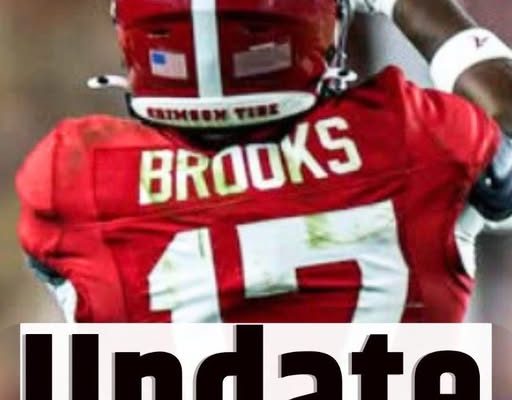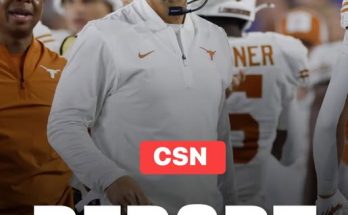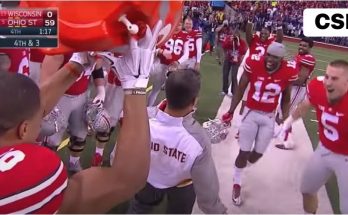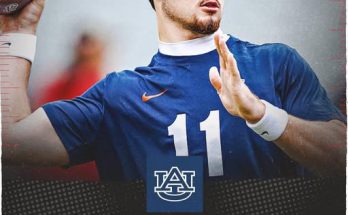Injuries are an unavoidable part of college football — a brutal reality that every coach, player, and fan comes to terms with as the season unfolds. For Alabama, a team accustomed to championship expectations and relentless physical play, even one injury can send ripples through the lineup and fanbase alike. This week, Alabama head coach Kalen DeBoer confirmed that freshman wide receiver Lotzeir Brooks will miss today’s game against South Carolina after suffering an injury in last week’s matchup. While the setback may seem minor on the surface, the news sheds light on the physical toll of the game, the depth of Alabama’s roster, and the patience required when nurturing young talent through adversity.
DeBoer, speaking to the Crimson Tide Sports Network, explained the situation with measured candor: “Lotzeir Brooks got dinged up in the game last week. Didn’t turn the corner like we probably thought he was gonna as the week went on.” That short but telling statement reveals two important truths — first, that Alabama’s staff initially believed Brooks might recover in time to suit up, and second, that the injury lingered longer than expected. In football terms, “dinged up” often implies a non-catastrophic but bothersome injury — perhaps a sprain, bruise, or muscle strain — yet for a player like Brooks, whose role depends heavily on explosiveness, even the smallest setback can mean the difference between being game-ready and sitting out.
For Brooks, this injury comes at a critical juncture in his young career. The freshman wideout, who entered Alabama’s program with a wave of anticipation, had begun to show flashes of why he was such a coveted recruit. His speed, precise route-running, and ability to create separation against top-tier defensive backs made him one of the more exciting new faces in Tuscaloosa. While his opportunities have been limited as part of a deep receiver rotation, every snap he’s taken has been valuable for his growth — and every missed game, equally, feels like a lost chance to continue developing chemistry with the quarterbacks and gaining the trust of the coaching staff.
Kalen DeBoer’s handling of the situation underscores his player-first philosophy, a trait that has already begun to define his leadership at Alabama. Known for his emphasis on discipline, preparation, and long-term success over short-term fixes, DeBoer’s decision to rest Brooks is as much about protecting the player as it is about protecting the program’s future. There’s a fine balance in college football between playing through pain and playing smart. DeBoer, who has built a reputation for player management and strategic decision-making, appears to be choosing the latter. “Didn’t turn the corner” may sound like a simple phrase, but it speaks volumes — it implies that the staff monitored Brooks throughout the week, hoping for progress, yet ultimately decided that forcing him back onto the field would not serve anyone well.
In Alabama’s system, injuries are rarely allowed to become excuses. The “next man up” mentality runs deep, forged through decades of elite recruiting and a culture that demands excellence from every player on the depth chart. While Brooks’ absence is disappointing, it also opens the door for others to step into the spotlight. Fellow receivers like Kobe Prentice, Malik Benson, or Jalen Hale could see expanded roles in the passing game. The Crimson Tide have long prided themselves on depth — a luxury few programs possess — and this week’s matchup with South Carolina will be another test of that depth.
Still, there’s no denying that Brooks’ skill set brings something unique to the field. His combination of agility, acceleration, and field awareness has already drawn comparisons to some of Alabama’s great receivers of the past. Losing that type of dynamic ability, even temporarily, slightly shifts the offensive rhythm. For a coaching staff that designs game plans around versatility and explosive playmaking, missing a player like Brooks can influence how routes are structured and how coverages are attacked. DeBoer’s offensive schemes thrive on timing, motion, and precision — elements that rely heavily on having all personnel in sync.
From a team morale standpoint, injuries like this can test unity but also strengthen it. Teammates rallying around Brooks during his recovery speaks to the brotherhood that defines Alabama football. It’s a culture where competitiveness doesn’t overshadow compassion, and where every player, whether starter or freshman reserve, is valued. Brooks’ presence on the sideline — even if he’s not suited up — will likely still carry influence. His energy, encouragement, and involvement during the game can inspire others, especially in a high-pressure SEC environment.
For DeBoer, this situation also highlights his adaptability as a head coach in his first season at Alabama. Coming off his success at Washington, where he developed a reputation for offensive innovation and player development, DeBoer entered the SEC spotlight with high expectations. Managing injuries to key contributors like Brooks is part of the challenge. It tests not only his tactical skills but also his communication with medical staff, assistants, and players. The way he balances competitive urgency with player welfare could shape his tenure in Tuscaloosa.
Injuries often serve as hidden storylines within a season. They can derail momentum, create opportunities, and reveal depth — or lack thereof. For Alabama, this one will likely be seen as a bump in the road rather than a major derailment. Yet it’s also a reminder of how fragile success can be in college football. Every week brings new physical tests, and every game demands full effort from bodies already battered by the grind of SEC play.
Fans will certainly hope Brooks’ absence is short-lived. Freshman years can be transformative, but only when players stay healthy enough to build confidence and continuity. A week or two off now could prevent a more serious setback later, especially if the medical team feels rest is the best path forward. In the modern game, where athletes are bigger, faster, and stronger than ever, recovery protocols have become just as important as playbooks. DeBoer’s emphasis on not rushing Brooks back into action aligns with a growing recognition across college football — that long-term performance matters more than short-term availability.
As Alabama takes the field against South Carolina, the focus will shift quickly from who isn’t playing to who is. The Tide still boast one of the most balanced offenses in the nation, and the quarterback will have no shortage of targets to distribute the ball to. But somewhere on the sideline, Lotzeir Brooks will be watching, learning, and waiting for his next opportunity. For young athletes like him, resilience is often forged in moments of frustration — when they’re forced to pause, reflect, and prepare for a comeback stronger than before.
DeBoer’s brief update may have been clinical, but behind it lies a deep awareness of what’s at stake. Alabama football isn’t just about winning games — it’s about developing men who can handle adversity both on and off the field. Injuries test not just muscles and joints but mental toughness, patience, and trust in the process. Brooks’ recovery will be as much about his mindset as his physical healing. In an environment that demands perfection, learning to step back and heal is sometimes the hardest lesson of all.
Ultimately, Alabama’s ability to adapt without Brooks this week will speak to the program’s enduring identity: a team built not on individual stars but on collective excellence. And when Brooks does return — whether next week or later in the season — his perspective may be sharper, his hunger deeper, and his contribution even more impactful. For now, Alabama will continue its march through the SEC gauntlet, guided by DeBoer’s steady hand and an unwavering belief that every setback can become a setup for a stronger finish.
Lotzeir Brooks’ story is still being written, and this injury is merely a chapter — one that could ultimately define his toughness and determination. For Alabama fans, the hope is simple: that this promising young receiver heals quickly, returns confidently, and continues to grow into the star he’s shown flashes of becoming. For DeBoer and his staff, the focus remains steadfast — protect the player, trust the system, and keep the Tide rolling, one game at a time.



